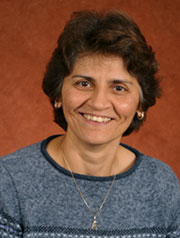CONTACT: Doug Carlson
(850) 645-1255 or (850) 694-3735
doug.carlson@med.fsu.edu
By Doug Carlson
January 2009

Jamila Horabin Ph.D.
TALLAHASSEE, Fla. -- A unique discovery in a Florida State University College of Medicine laboratory is the basis for research with the potential to one day help scientists learn how to stop cancer and other diseases in the tissue where they are forming.
Jamila Horabin, associate professor of biomedical sciences at the College of Medicine, has received a four-year, $1.2 million grant from the National Institutes of Health to pursue her work. Horabin recently discovered a direct link between RNA silencing and the genetic master switch controlling the sex determination process in fruit flies.
With that knowledge, she is now seeking to fully understand how a cellular process in gene regulation called the RNA-induced silencing complex (RISC) might interfere with or silence the genes assumed to be at work in nearly all forms of disease and cancer. With a greater understanding of the process, her hope is that scientists will one day be able to switch off the gene activity causing cancerous tumors and cardiovascular disease.
“We want to know how RNA silencing affects fundamental gene expression,” Horabin said. “Many genes are regulated by this process, and it will have far-reaching impact if we understand how it works, which is really the hope and dream of a basic scientist.”
Myra Hurt, associate dean for research and graduate programs at the College of Medicine, said Horabin’s work has great potential for finding a new way of fighting disease.
“There are a number of genes involved with tumor development and metastasis, for example,” Hurt said. “Imagine if you could target those genes and silence them in the tissue where they are. Here is one more layer of gene regulation that we really didn’t know about until fairly recently, and now if we can understand it maybe we can use this technology to target genes involved in disease conditions very specifically and silence them.”
The fruit fly offers numerous advantages for such research. Its genome has been fully mapped, so every gene is known and can be studied for cause and effect relationships in the laboratory. Additionally, the fruit fly reaches full maturity in a matter of days, is plentiful, inexpensive and, most importantly, shares remarkable similarities to humans at the level where gene activity is regulated.
“Sometimes you find that the fly gene that you are working with is similar to a human gene that is involved in directing a disease,” Horabin said. “So if the fly gene is being regulated in a particular way, then odds are the human gene is being regulated the very same way.”

